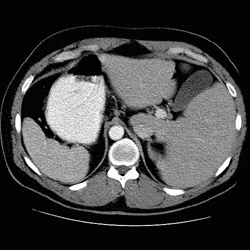
RADIOLOGY: ABDOMEN: Case# 32: SITUS INVERSUS. 45 year old male with cirrhosis and left upper quadrant pain for one year. There is complete situs inversus. The liver is only mildly cirrhotic in configuration with slight prominence of the caudate and left hepatic lobes. No focal hepatic lesions are seen. The spleen is moderately enlarged. There is extensive diverticulosis of the colon. Normal anatomical positioning is termed situs solitus. The cardiac apex, aortic arch, and stomach are all normally on the left. In addition, the anatomic left atrium is on the same side as the hyparterial bronchus and bilobed lung; the anatomic right atrium is on the same side as the eparterial bronchus and trilobed lung. With normal situs and levocardia, the incidence of congenital heart disease is less than 1%; with dextrocardia, the incidence rises to 95%. As shown above, situs inversus is a mirror image of normal anatomy. In situs inversus totalis, the cardiac apex, stomach and aortic arch are all on the right. Situs inversus totalis is associated with a 5-10% incidence of congenital heart disease. Situs inversus with levocardia (right-sided stomach and left-sided heart) is associated with congenital heart disease in 95% of cases, but is very rare. Kartageners syndrome may also be seen in connection with situs inversus. Kartageners syndrome represents a triad of situs inversus (seen in 50% of cases), sinusitis, and bronchiectasis. The latter two parts of the triad are due to immotile or dysmotile cilia affecting the respiratory epithelium, auditory epithelium, and the sperm in males; therefore, hearing difficulties and infertility may also be found in this syndrome. Two other situs abnormalities are worth noting. Situs ambiguous with bilateral "right-sidedness" is known as Asplenia syndrome. In this syndrome, the spleen is absent, both lungs have three lobes, and the left and right lobes of the liver are similar. The cardiac apex may be in either hemithorax. Complex cardiac anomalies are usually found in this syndrome. Situs ambiguous with bilateral "left-sidedness" is called Polysplenia syndrome. The lungs each have two lobes, multiple small spleens are present, and the cardiac apex may be in either hemithorax. The cardiac anomalies associated with polysplenia syndrome are less complex giving this syndrome a better prognosis than asplenia syndrome.